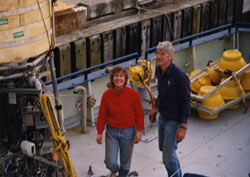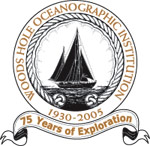This is an archived site. This site is no longer being maintained or reviewed for broken links.
Employee Portrait Gallery—Joanne Goudreau
 |
|
|
Joanne Goudreau and Fred Sayles were loading Oceanus for a ROLAID cruise in 1990 when this photo was taken. (Photo by Peggy Dickinson)
|
In the first grade at Woods Hole School, Joanne Goudreau answered the question "What do you want to be when you grow up?" with "I want to be a scientist at MBL." Nine years later, in 1971, 15-year-old Joanne was looking for a job when Fred Sayles needed a lab “dishwasher.” MBL’s loss—she signed on at WHOI, spent high school and college summers and breaks working, and then joined the Chemistry Department full time when she finished her studies at UMass Amherst in 1977.
Joanne says her work in the department over the years “has provided me the opportunity to learn an extensive variety of skills: chemical and radiochemical techniques, ever-changing computer skills, and mechanical operations, such as the meticulous development of micro-electrodes and sampling techniques.” Her roles have included serving as project head, chief analyst, and chief scientist, and she has participated in 26 extended cruises and more than 100 one- to two-day cruises.
As a member of Vaughan Bowen’s radiochemistry lab group, Joanne finally got out of New England on her first cruise aboard Atlantis II during a January college break. With Bowen's retirement in 1982, Joanne rejoined the Sayles lab. She counts one of Fred’s bottom-lander programs as a source of special pride. It involved 22 deployments of the ROLAID lander off Bermuda over a six-year period (1988–1993). ROLAID (for Robotically Operated Lander for the Analysis of Interfacial Diagenesis—and also for the heartburn involved in developing it!) collected pore water, flux chamber, and sediment samples and made a variety of measurements. Extreme care was required to keep its complex suite of instruments functional for month-long deployments—including consideration of the weight of everything on it, down to each washer, to maintain its buoyancy precisely.
On her way to the Bermuda Biological Station’s Weatherbird one day, Joanne was knocked off her bicycle by a car. Wayne Dickinson patched her up with paper towels and black tape for the trip to the hospital. Since Joanne was the only one who knew how to accomplish a number of the critical cruise tasks, they held the ship’s departure. With stitches at her elbow and limping on a “minor” ankle fracture, she boarded the ship, and the deployment carried on.
In addition to serving on both analysis and mechanical teams for ROLAID, Joanne has been involved in studies ranging from Russian nuclear waste to analysis of calcium carbonate dissolution on the seafloor and deployment of another lander, WHIMP (Woods Hole Interstitial Marine Probe), during a six-week cruise in the Southern Ocean. Among other projects, she is currently the mechanic/analyst for Fred Sayles’s OSPRE and small landers known as SQUIRTS (SeQUencially sampled Insitu Respirometer Tripod) for Bill Martin’s sediment flux studies of Boston and Hingham Harbors.
Outside the lab, Joanne’s activities include racing her Mirror Dinghy, and she is devoted to “Beau,” her Egyptian Arabian horse.
[back]

